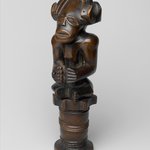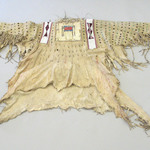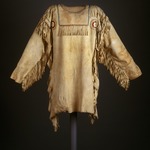Sidefold Dress
Arts of the Americas
One of the earliest Northern Plains styles was the side-fold dress, constructed of tanned hide wrapped around the wearer and sewn closed on one side. Six pieces of hide were cut and joined together to construct this garment. The blue, brown, and white quilled decoration of parallel horizontal stripes is framed by tufts of red yarn. The tinned iron and copper cones sewn along the bottom were valued trade goods, and therefore prestige ornamentation for a Yankton woman in the nineteenth century.
MEDIUM
Buffalo hide(?), dyed bird and porcupine quills, copper, tinned iron and copper cones, glass pony beads, yarn, pigment, sinew
DATES
early 19th century
ACCESSION NUMBER
50.67.6
CREDIT LINE
Henry L. Batterman Fund and Frank Sherman Benson Fund
PROVENANCE
Prior to 1848, provenance not yet documented; by 1848, acquired by Nathan Sturges Jarvis; 1848, gift of Nathan Sturges Jarvis to the New-York Historical Society, New York, NY; 1937, loaned by the New-York Historical Society to the Brooklyn Museum; 1950, purchased from the New-York Historical Society by the Brooklyn Museum.
Provenance FAQ
CATALOGUE DESCRIPTION
Woman's side-fold hide dress consists of six pieces: the main body of the dress, the flounce, the shoulder flap, the top bodice, and two hide thongs as a second shoulder strap. The horizontal seam is low and the folded over portion is shorter and would barely cover the breast. The folded over flap is even shorter in the back. The hide is worked so that the flesh side of the skin lies against the wearer, with the fur side out. The flounce is laced with hide thong. The seam of the dress, the blue and white pony beads on the shoulder strap, and the hem tabs are all sewn. It is likely that the two bottom tabs at the left side of the dress are formed from a remnant of the foreleg of the animal or are a decorative form to resemble this pattern technique imitating the animal's legs.
Ten quilled stripes are worked around the skirt of the dress, horizontally, in measured registers of blue (once blue-green but faded since original BMA acquisition) and brown quill, separated by shorter sections of white porcupine quill where red tufts, once the tassels, of yarn emerge. Small black lines separate each quilled section. Some vertical marks of what is probably ochre appear at the ends of the quilled bands.
Tin cones and a few copper cones are sewn to the bottom of the flounce, more or less at knee length, and on the two bottom tabs, which are further elaborated with an edging of blue and white beads. Five pairs of copper cones are sewn up the side seam. If the shoulder strap is examined from above, blue and white beads can be seen ornamenting the seams. A single row or blue beads edges the sides while the front and back seams display eight bands of two rows of white beads alternating with two rows of blue pony beads. See Jarvis supplemental file in Arts of Americas office or Brooklyn Museum Library.
MUSEUM LOCATION
This item is not on view
CAPTION
Yankton, Nakota, Sioux. Sidefold Dress, early 19th century. Buffalo hide(?), dyed bird and porcupine quills, copper, tinned iron and copper cones, glass pony beads, yarn, pigment, sinew, 50 x 16 in. (127 x 40.6 cm). Brooklyn Museum, Henry L. Batterman Fund and Frank Sherman Benson Fund, 50.67.6. Creative Commons-BY (Photo: Brooklyn Museum, 50.67.6_SL1.jpg)
IMAGE
overall, 50.67.6_SL1.jpg. Brooklyn Museum photograph
"CUR" at the beginning of an image file name means that the image was created by a curatorial staff member. These study images may be digital point-and-shoot photographs, when we don\'t yet have high-quality studio photography, or they may be scans of older negatives, slides, or photographic prints, providing historical documentation of the object.
RIGHTS STATEMENT
Creative Commons-BY
You may download and use Brooklyn Museum images of this three-dimensional work in accordance with a
Creative Commons license. Fair use, as understood under the United States Copyright Act, may also apply.
Please include caption information from this page and credit the Brooklyn Museum. If you need a high resolution file, please fill out our online
application form (charges apply).
For further information about copyright, we recommend resources at the
United States Library of Congress,
Cornell University,
Copyright and Cultural Institutions: Guidelines for U.S. Libraries, Archives, and Museums, and
Copyright Watch.
For more information about the Museum's rights project, including how rights types are assigned, please see our
blog posts on copyright.
If you have any information regarding this work and rights to it, please contact
copyright@brooklynmuseum.org.
RECORD COMPLETENESS
Not every record you will find here is complete. More information is available for some works than for others, and some entries have been updated more recently. Records are frequently reviewed and revised, and
we welcome any additional information you might have.




























